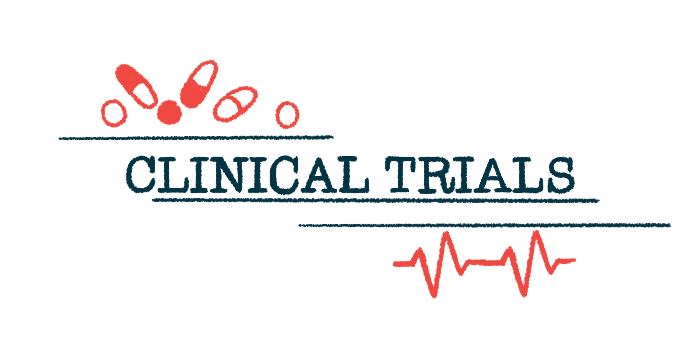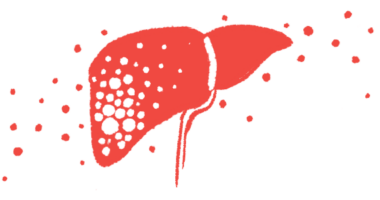Severe fatty liver disease patients see benefits with lanifibranor
Study tested effects with therapy alone, with diabetes medication Jardiance

Inventiva’s investigational oral therapy lanifibranor safely reduced blood sugar levels and eased signs of liver disease among people with metabolic dysfunction-associated steatohepatitis (MASH), a severe type of fatty liver disease, and poorly controlled type 2 diabetes (T2D).
These are the findings of an interim data analysis from the Phase 2 LEGEND clinical trial (NCT05232071), wherein participants were given either lanifibranor alone or with Boehringer Ingelheim’s diabetes medication Jardiance (empagliflozin), or a placebo. Type 2 diabetes is marked by high blood sugar (glucose) due to an abnormal response to the hormone insulin, which regulates its levels.
The early results, detailed in a recent company webcast, indicate the study has met its main goal and several secondary ones, so Inventiva won’t recruit more participants.
“The results of the LEGEND study … further illustrate the potential of lanifibranor to address the broad spectrum of the disease biology of MASH and T2D,” Michael Cooreman, MD, Inventiva’s chief medical officer, said in a company press release. “With roughly 50% of the U.S. population estimated to have either prediabetes or diabetes, and the well-established correlation between MASH and T2D, lanifibranor has a unique mechanism of action to potentially address the medical need of patients with both MASH and T2D.”
The ongoing Phase 3 NATIV3 trial (NCT04849728) is evaluating lanifibranor against a placebo in MASH patients with advanced liver fibrosis, or scarring. The trial is recruiting more than 1,000 participants at nearly 500 sites globally.
In MASH, fatty deposits that have accumulated in the liver (steatosis) cause inflammation and fibrosis. The disease was formerly known as nonalcoholic steatohepatitis, or NASH. It’s associated with cardiometabolic risk factors such as type 2 diabetes and obesity and managing these conditions is a major part of treating MASH and limiting further liver damage.
What is lanifibranor?
Lanifibranor is an oral small molecule activator of PPARs, a family of proteins that regulate genes implicated in MASH-related processes, such as inflammation, fibrosis, and certain metabolic factors.
The therapy received breakthrough therapy and fast track designations in the U.S. for treating MASH, designations that are meant to accelerate its clinical development and regulatory review.
In previous Phase 2 trials, lanifibranor was associated with reduced disease activity in MASH patients, along with reductions in liver fat and improvements in insulin sensitivity and glucose metabolism in people with fatty liver disease and T2D.
The proof-of-concept LEGEND trial was designed to evaluate lanifibranor’s safety and efficacy in MASH patients with poorly controlled T2D when used alone or with Jardiance. Inventiva believes this combination might have additional metabolic benefits for MASH patients with diabetes.
“MASH is a multifaceted disease that we believe will benefit from combination therapies in order to properly address the full cardiometabolic spectrum of the disease,” said Michelle Lai, MD, PhD, of Beth Israel Deaconess Medical Center and one of LEGEND’s principal investigators.
The trial originally planned to enroll 63 participants who would be randomly assigned to either once daily lanifibranor (800 mg), with or without Jardiance (10 mg), or a placebo, for 24 weeks (about six months). The interim analysis was conducted when half the planned number of participants had completed the treatment period or discontinued it.
Effects of lanifibranor in LEGEND
The study met its main goal of demonstrating that lanifibranor alone or with Jardiance was superior to a placebo at reducing levels of HbA1c, an indicator of a person’s average blood sugar levels over three months.
Lanifibranor and the lanifibranor/Jardiance combo led to 1.14% and 1.59% reductions, respectively, in HbA1c levels after six months of treatment. Levels in the placebo group increased by 0.26%.
Also, statistically significant reductions in liver steatosis were observed with lanifibranor alone (47%) or with Jardiance (38%) relative to a placebo, where no change was observed.
Most patients in the lanifibranor (82%) or lanifibranor/Jardiance (67%) treatment arms showed a reduction by at least 30% in liver fat, compared with none on a placebo.
The study also demonstrated an effect in several other secondary and exploratory goals, including levels of liver damage, inflammation, and fibrosis markers, as well as in metabolic markers and insulin sensitivity.
While weight gain occurs in some people on lanifibranor, those in the combined therapy group maintained a stable weight throughout the study. Moreover, both treatment groups showed a significant reduction in the ratio of visceral, or deep in the organs, to subcutaneous (under the skin) fat tissue, meaning less visceral fat. The placebo group saw an increase. This “reflects a shift from pro-inflammatory visceral fat towards metabolically healthy adipose tissue,” Inventiva noted in the release.
The treatment was well tolerated, with no safety concerns reported.
“These results of LEGEND suggest that lanifibranor in combination with [Jardiance] could be an ideal combination for patients we care for in our clinic who suffer from T2D and MASH,” Lai said.






